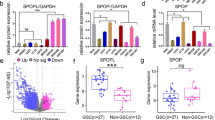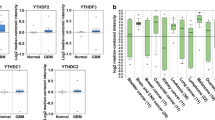Abstract
Glioma is the most common malignant brain tumor, and its behavior is closely related to the presence of glioma stem cells (GSCs). We found that the enhancer of zeste homolog 2 (EZH2) is highly expressed in glioma and that its expression is correlated with the prognosis of glioblastoma multiforme (GBM) in two databases: The Cancer Genome Atlas and the Chinese Glioma Genome Atlas. Additionally, EZH2 is known to regulate the stemness-associated gene expression, proliferation, and invasion ability of GSCs, which may be achieved through the activation of the STAT3 and Notch1 pathways. Furthermore, we demonstrated the effect of the EZH2-specific inhibitor GSK126 on GSCs; these results not only corroborate our hypothesis, but also provide a potential novel treatment approach for glioma.



Similar content being viewed by others
Data availability
The datasets generated during and/or analyzed during the current study are available from the corresponding author on reasonable request.
References
Aster JC, Pear WS, Blacklow SC (2017) The varied roles of notch in cancer. Annu Rev Pathol 12:245–275
Bao S, Wu Q, McLendon RE et al (2006) Glioma stem cells promote radioresistance by preferential activation of the DNA damage response. Nature 444(7120):756–760
Bianchi S, Dotti MT, Federico A (2006) Physiology and pathology of notch signalling system. J Cell Physiol 207(2):300–308
Brennan CW, Verhaak RG, McKenna A, Campos B, Noushmehr H, Salama SR, Zheng S, Chakravarty D, Sanborn JZ, Berman SH, Beroukhim R, Bernard B, Wu CJ, Genovese G, Shmulevich I, Barnholtz-Sloan J, Zou L, Vegesna R, Shukla SA, Ciriello G, Yung WK, Zhang W, Sougnez C, Mikkelsen T, Aldape K, Bigner DD, Van Meir EG, Prados M, Sloan A, Black KL, Eschbacher J, Finocchiaro G, Friedman W, Andrews DW, Guha A, Iacocca M, O’Neill BP, Foltz G, Myers J, Weisenberger DJ, Penny R, Kucherlapati R, Perou CM, Hayes DN, Gibbs R, Marra M, Mills GB, Lander E, Spellman P, Wilson R, Sander C, Weinstein J, Meyerson M, Gabriel S, Laird PW, Haussler D, Getz G, Chin L (2013) The somatic genomic landscape of glioblastoma. Cell 155(2):462–477. https://doi.org/10.1016/j.cell.2013.09.034
Chen H, Aksoy I, Gonnot F et al (2015) Reinforcement of STAT3 activity reprogrammes human embryonic stem cells to naive-like pluripotency. Nat Commun 6:7095
Chen X, Hu L, Yang H et al (2019) DHHC protein family targets different subsets of glioma stem cells in specific niches. J Exp Clin Cancer Res 38(1):25
Chillakuri CR, Sheppard D, Lea SM, Handford PA (2012) Notch receptor-ligand binding and activation: insights from molecular studies. Semin Cell Dev Biol 23(4):421–428
Codrici E, Enciu AM, Popescu ID, Mihai S, Tanase C (2016) Glioma stem cells and their microenvironments: providers of challenging therapeutic targets. Stem Cells Int 2016:5728438
Dong F, Eibach M, Bartsch JW, Dolga AM, Schlomann U, Conrad C, Schieber S, Schilling O, Biniossek ML, Culmsee C, Strik H, Koller G, Carl B, Nimsky C (2015) The metalloprotease-disintegrin ADAM8 contributes to temozolomide chemoresistance and enhanced invasiveness of human glioblastoma cells. Neuro Oncol 17:1474–1485
Eich ML, Athar M, Ferguson JE, Varambally S (2020) EZH2-targeted therapies in cancer: hype or a reality. Cancer Res 80(24):5449–5458. https://doi.org/10.1158/0008-5472.CAN-20-2147
Guanizo AC, Fernando CD, Garama DJ, Gough DJ (2018) STAT3: a multifaceted oncoprotein. Growth Factors 36(1–2):1–14
Guryanova OA, Wu Q, Cheng L et al (2011) Nonreceptor tyrosine kinase BMX maintains self-renewal and tumorigenic potential of glioblastoma stem cells by activating STAT3. Cancer Cell 19(4):498–511
Hardee ME, Zagzag D (2012) Mechanisms of glioma-associated neovascularization. Am J Pathol 181(4):1126–1141
Huang Q, Zhang QB, Dong J, Wu YY, Shen YT, Zhao YD, Zhu YD, Diao Y, Wang AD, Lan Q (2008) Glioma stem cells are more aggressive in recurrent tumors with malignant progression than in the primary tumor, and both can be maintained long-term in vitro. BMC Cancer 8:304. https://doi.org/10.1186/1471-2407-8-304
Jahan N, Lee JM, Shah K, Wakimoto H (2017) Therapeutic targeting of chemoresistant and recurrent glioblastoma stem cells with a proapoptotic variant of oncolytic herpes simplex virus. Int J Cancer 141(8):1671–1681. https://doi.org/10.1002/ijc.30811
Jhaveri N, Chen TC, Hofman FM (2016) Tumor vasculature and glioma stem cells: contributions to glioma progression. Cancer Lett 380(2):545–551
Johnson BE, Mazor T, Hong C, Barnes M, Aihara K, McLean CY, Fouse SD, Yamamoto S, Ueda H, Tatsuno K, Asthana S, Jalbert LE, Nelson SJ, Bollen AW, Gustafson WC, Charron E, Weiss WA, Smirnov IV, Song JS, Olshen AB, Cha S, Zhao Y, Moore RA, Mungall AJ, Jones S, Hirst M, Marra MA, Saito N, Aburatani H, Mukasa A, Berger MS, Chang SM, Taylor BS, Costello JF (2014) Mutational analysis reveals the origin and therapy-driven evolution of recurrent glioma. Science 343(6167):189–193. https://doi.org/10.1126/science.1239947
Kim E, Kim M, Woo DH, Shin Y, Shin J, Chang N, Oh YT, Kim H, Rheey J, Nakano I, Lee C, Joo KM, Rich JN, Nam DH, Lee J (2013) Phosphorylation of EZH2 activates STAT3 signaling via STAT3 methylation and promotes tumorigenicity of glioblastoma stem-like cells. Cancer Cell 23:839–852
Li X, Tao Z, Wang H, Deng Z, Zhou Y, Du Z (2020) Dual inhibition of Src and PLK1 regulate stemness and induce apoptosis through Notch1-SOX2 signaling in EGFRvIII positive glioma stem cells (GSCs). Exp Cell Res 396(1):112261. https://doi.org/10.1016/j.yexcr.2020.112261
Liebelt BD, Shingu T, Zhou X, Ren J, Shin SA, Hu J (2016) Glioma Stem Cells: Signaling, Microenvironment, and Therapy. Stem Cells Int 2016:7849890
Lim HJ, Kim M (2020) EZH2 as a potential target for NAFLD therapy. Int J Mol Sci 21(22):8617. https://doi.org/10.3390/ijms21228617
Lindsell CE, Boulter J, diSibio G, Gossler A, Weinmaster G (1996) Expression patterns of Jagged, Delta1, Notch1, Notch2, and Notch3 genes identify ligand-receptor pairs that may function in neural development. Mol Cell Neurosci 8(1):14–27
Liu H, Sun Y, Qi X, Gordon RE, O’Brien JA, Yuan H, Zhang J, Wang Z, Zhang M, Song Y, Yu C, Gu C (2019) EZH2 Phosphorylation promotes self-renewal of glioma stem-like cells through NF-κB methylation. Front Oncol 9:641. https://doi.org/10.3389/fonc.2019.00641
Ma Q, Long W, Xing C et al (2018) Cancer stem cells and immunosuppressive microenvironment in glioma. Front Immunol 9:2924
Mahabir R, Tanino M, Elmansuri A, Wang L, Kimura T, Itoh T, Ohba Y, Nishihara H, Shirato H, Tsuda M, Tanaka S (2014) Sustained elevation of Snail promotes glial-mesenchymal transition after irradiation in malignant glioma. Neuro Oncol 16(5):671–685. https://doi.org/10.1093/neuonc/not239
Nutt SL, Keenan C, Chopin M, Allan RS (2020) EZH2 function in immune cell development. Biol Chem 401(8):933–943
Omuro AM, Faivre S, Raymond E (2007) Lessons learned in the development of targeted therapy for malignant gliomas. Mol Cancer Ther 6(7):1909–1919
Pasini D, Di Croce L (2016) Emerging roles for Polycomb proteins in cancer. Curr Opin Genet Dev 36:50–58
Pushpakom S, Iorio F, Eyers PA, Escott KJ, Hopper S, Wells A, Doig A, Guilliams T, Latimer J, McNamee C, Norris A, Sanseau P, Cavalla D, Pirmohamed M (2019) Drug repurposing: progress, challenges and recommendations. Nat Rev Drug Discov 18(1):41–58. https://doi.org/10.1038/nrd.2018.168
Rahal F, Capdevielle C, Rousseau B, Izotte J, Dupuy JW, Cappellen D, Chotard G, Ménard M, Charpentier J, Jecko V, Caumont C, Gimbert E, Grosset CF, Hagedorn M (2022) An EZH2 blocker sensitizes histone mutated diffuse midline glioma to cholesterol metabolism inhibitors through an off-target effect. Neurooncol Adv 4(1):018. https://doi.org/10.1093/noajnl/vdac018
Ratnam NM, Sonnemann HM, Frederico SC, Chen H, Hutchinson M, Dowdy T, Reid CM, Jung J, Zhang W, Song H, Zhang M, Davis D, Larion M, Giles AJ, Gilbert MR (2021) Reversing epigenetic gene silencing to overcome immune evasion in cns malignancies. Front Oncol 11:719091. https://doi.org/10.3389/fonc.2021.719091
Rolle CE, Sengupta S, Lesniak MS (2010) Challenges in clinical design of immunotherapy trials for malignant glioma. Neurosurg Clin N Am 21(1):201–214
Sgrignani J, Garofalo M, Matkovic M, Merulla J, Catapano CV, Cavalli A (2018) Structural biology of STAT3 and Its implications for anticancer therapies development. Int J Mol Sci 19(6):1591
Simon JA, Lange CA (2008) Roles of the EZH2 histone methyltransferase in cancer epigenetics. Mutat Res 647(1–2):21–29
Smits M, van Rijn S, Hulleman E, Biesmans D, van Vuurden DG, Kool M, Haberler C, Aronica E, Vandertop WP, Noske DP, Würdinger T (2012) EZH2-regulated DAB2IP is a medulloblastoma tumor suppressor and a positive marker for survival. Clin Cancer Res 18(15):4048–4058. https://doi.org/10.1158/1078-0432.CCR-12-0399
Tamura K, Aoyagi M, Ando N, Ogishima T, Wakimoto H, Yamamoto M, Ohno K (2013) Expansion of CD133-positive glioma cells in recurrent de novo glioblastomas after radiotherapy and chemotherapy. J Neurosurg 119(5):1145–1155. https://doi.org/10.3171/2013.7.JNS122417
Tan M, Sandanaraj E, Chong YK et al (2019) A STAT3-based gene signature stratifies glioma patients for targeted therapy. Nat Commun 10(1):3601
Tao Z, Li X, Wang H, Chen G, Feng Z, Wu Y, Yin H, Zhao G, Deng Z, Zhao C, Li Y, Sun T, Zhou Y (2020) BRD4 regulates self-renewal ability and tumorigenicity of glioma-initiating cells by enrichment in the Notch1 promoter region. Clin Transl Med 10(6):181. https://doi.org/10.1002/ctm2.181
Van Aller GS, Pappalardi MB, Ott HM, Diaz E, Brandt M, Schwartz BJ, Miller WH, Dhanak D, McCabe MT, Verma SK, Creasy CL, Tummino PJ, Kruger RG (2014) Long residence time inhibition of EZH2 in activated polycomb repressive complex 2. ACS Chem Biol 9(3):622–629. https://doi.org/10.1021/cb4008748
Verma A, Singh A, Singh MP, Nengroo MA, Saini KK, Satrusal SR, Khan MA, Chaturvedi P, Sinha A, Meena S, Singh AK, Datta D (2022) EZH2-H3K27me3 mediated KRT14 upregulation promotes TNBC peritoneal metastasis. Nat Commun 13(1):7344. https://doi.org/10.1038/s41467-022-35059-x
Wen PY, Kesari S (2008) Malignant gliomas in adults. N Engl J Med 359(5):492–507
Wen Y, Cai J, Hou Y, Huang Z, Wang Z (2017) Role of EZH2 in cancer stem cells: from biological insight to a therapeutic target. Oncotarget 8(23):37974–37990
Weng HR, Taing K, Chen L, Penney A (2023) EZH2 Methyltransferase regulates neuroinflammation and neuropathic pain. Cells 12(7):1758. https://doi.org/10.3390/cells12071058
Yang Q, Zhao S, Shi Z, Cao L, Liu J, Pan T, Zhou D, Zhang J (2021) Chemotherapy-elicited exosomal miR-378a-3p and miR-378d promote breast cancer stemness and chemoresistance via the activation of EZH2/STAT3 signaling. J Exp Clin Cancer Res 40:120
Yi L, Zhou X, Li T et al (2019) Notch1 signaling pathway promotes invasion, self-renewal and growth of glioma initiating cells via modulating chemokine system CXCL12/CXCR4. J Exp Clin Cancer Res 38(1):339
Yu H, Pardoll D, Jove R (2009) STATs in cancer inflammation and immunity: a leading role for STAT3. Nat Rev Cancer 9(11):798–809
Zhai Y, Li G, Li R et al (2020) Single-Cell RNA-sequencing shift in the interaction pattern between glioma stem cells and immune cells during tumorigenesis. Front Immunol 11:581209
Zheng X, Pang B, Gu G, Gao T, Zhang R, Pang Q, Liu Q (2017) Melatonin Inhibits Glioblastoma Stem-like cells through Suppression of EZH2–NOTCH1 Signaling Axis. Int J Biol Sci 13:245–253
Acknowledgements
We thank the Brain and Nerve Research Laboratory for providing technical instruction.
Funding
This work was supported by Suzhou Science and Technology Plan Projects (SYS2020123), Wujiang Science, Education, and Health Project (WWK202112), and Suzhou Ninth People’s Hospital Research Fund Project (YK202128).
Author information
Authors and Affiliations
Corresponding author
Ethics declarations
Conflict of interest
The authors declare that there is no conflict of interest regarding the publication of this paper.
Additional information
Communicated by Sreedharan Sajikumar.
Publisher's Note
Springer Nature remains neutral with regard to jurisdictional claims in published maps and institutional affiliations.
Supplementary Information
Below is the link to the electronic supplementary material.
Rights and permissions
Springer Nature or its licensor (e.g. a society or other partner) holds exclusive rights to this article under a publishing agreement with the author(s) or other rightsholder(s); author self-archiving of the accepted manuscript version of this article is solely governed by the terms of such publishing agreement and applicable law.
About this article
Cite this article
Zhao, G., Deng, Z., Li, X. et al. Targeting EZH2 regulates the biological characteristics of glioma stem cells via the Notch1 pathway. Exp Brain Res 241, 2409–2418 (2023). https://doi.org/10.1007/s00221-023-06693-8
Received:
Accepted:
Published:
Issue Date:
DOI: https://doi.org/10.1007/s00221-023-06693-8




